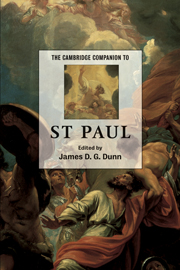Book contents
- Frontmatter
- Introduction
- Part I Paul’s life and work
- Part II Paul’s letters
- 3 1 and 2 Thessalonians
- 4 Galatians
- 5 1 and 2 Corinthians
- 6 Romans
- 7 Philippians
- 8 Colossians and Philemon
- 9 Ephesians
- 10 The Pastoral Epistles
- Part III Paul’s theology
- Part IV St Paul
- Select bibliography
- Index of References
- General Index
3 - 1 and 2 Thessalonians
from Part II - Paul’s letters
Published online by Cambridge University Press: 28 May 2006
- Frontmatter
- Introduction
- Part I Paul’s life and work
- Part II Paul’s letters
- 3 1 and 2 Thessalonians
- 4 Galatians
- 5 1 and 2 Corinthians
- 6 Romans
- 7 Philippians
- 8 Colossians and Philemon
- 9 Ephesians
- 10 The Pastoral Epistles
- Part III Paul’s theology
- Part IV St Paul
- Select bibliography
- Index of References
- General Index
Summary
HISTORICAL CONTEXT
On a day in the late 40s or early 50s, after some years of missionary work in Syria, Arabia, and Asia Minor, Paul sailed from Troas and landed in Europe, acting on his intention to spread his gospel proclamation in territory 'where Christ had not yet been named' (Rom. 15:20). Travelling along the Via Egnatia, the major thoroughfare from the East to Rome, Paul would have encountered a great range of artisans, peddlers, slaves, sailors, traders, farmers, and civil servants, alongside the formidable presence of the Roman military. When he stepped off the highway in Macedonia, first at Philippi and then at Thessalonica, Paul entered cities known for long and fervent associations with the cult of Roma and the Emperor. He came bearing a message crystallized in the proclamation, Kyrios Iesous ('Jesus is Lord', 1 Cor. 12:3), a confession destined to collide with the customary acclamation, Kyrios Caesar, 'Caesar is Lord' (see Acts 17:7). In this early encounter, the 'living and true God' (1 Thess. 1:9)was preached in the capital of the Roman province of Macedonia, whose local coins a mere half century before had boldly designated Julius Caesar as theos, 'god'. Thessalonica’s position, as both trade station on the Via Egnatia and chief Macedonian port on the Thermaic Gulf, ensured a rich and cosmopolitan mix of available religious options – the Hellenistic-Egyptian cults of Isis, Osiris, and Sarapis, the local cult of the Kabeiroi, and the Olympian gods Zeus (Hypsistos, ‘the highest’), Apollo, and Aphrodite, as well as Herakles, the Dioskouroi, and the ever-popular Dionysos.
- Type
- Chapter
- Information
- The Cambridge Companion to St Paul , pp. 51 - 63Publisher: Cambridge University PressPrint publication year: 2003
- 3
- Cited by



